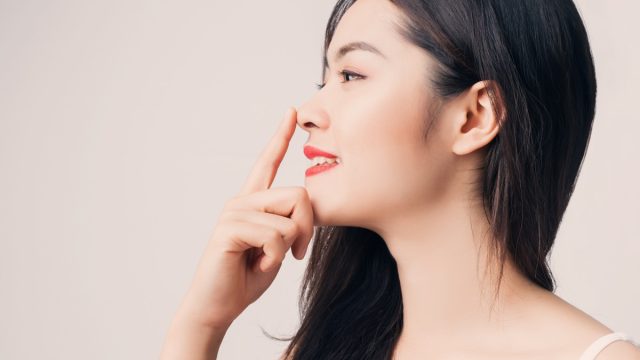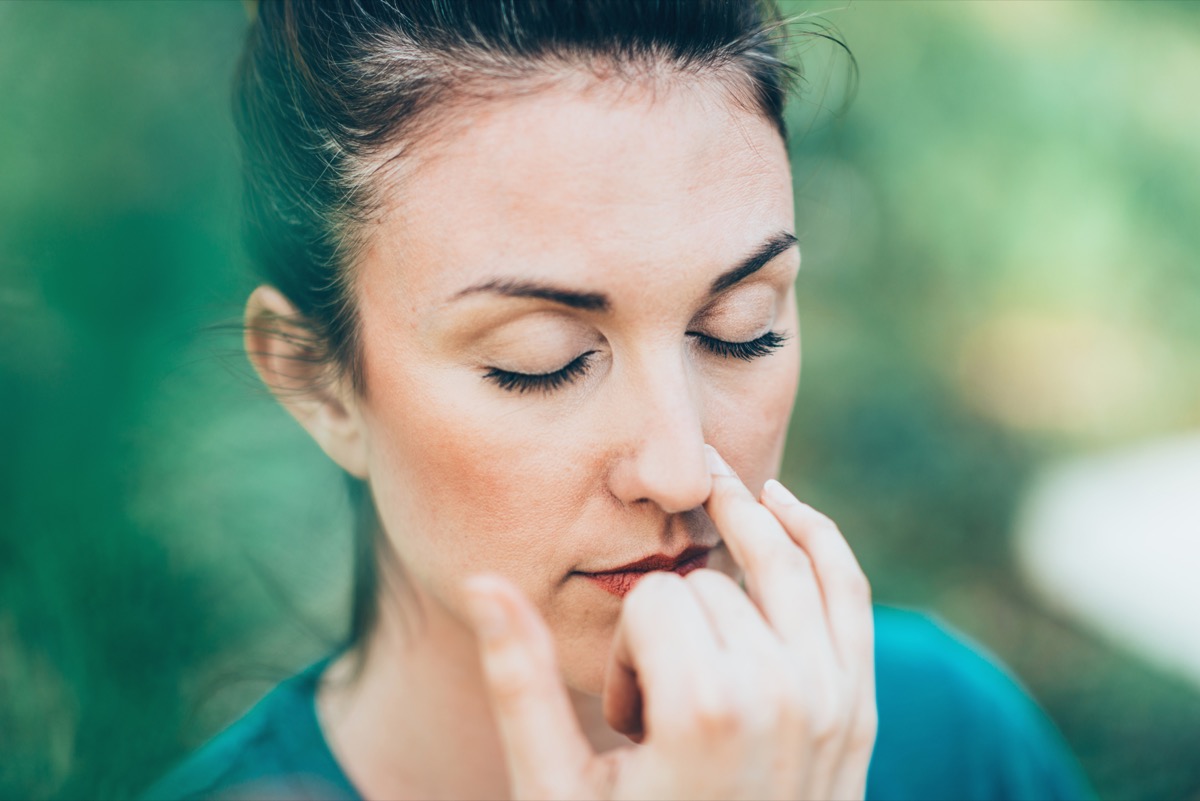6 Weird Facts You Didn't Know About Your Nose
It's all happening right under your you-know-what.

An essential part of both your respiratory and olfactory systems, your nose helps you breathe and smell—but that's not all it does. Experts say the nose also has some surprising features that most of us are unaware of. In fact, every time you breathe, sneeze, or speak, your nose is probably performing one of these fascinating functions. Read on to learn six weird facts you didn't know about your nose, and get ready to have a whole new appreciation for this miraculous body part.
READ THIS NEXT: If You Can't Smell These 3 Foods, Get Checked for Parkinson's, Experts Say.
1
You usually breathe through one nostril at a time.

Your nose is a single structure, divided by the septum into two openings—the nostrils. While for most of us, it feels as though we are breathing evenly through both nostrils at all times, experts say we actually use one dominant nostril to do most of the heavy lifting of respiration, then switch sides. "At any given time, people do about 75 percent of their breathing from one nostril and 25 percent from the other," reports Live Science.
Their experts say you can try this fun experiment at home: "If you get close to a mirror and breathe out through your nose, the mirror will fog up. Two marks of water vapor will pool on the surface, one for each nostril. But one mark will be larger than the other, because people breathe mostly out of one nostril at a time."
2
Your nose humidifies air before it reaches your lungs.

As one of your body's primary pathways to your lungs, the nose performs an important function: it humidifies your breath. It does this by sending the air through the conchae, a series of narrow bony structures located in the upper nasal cavity, which moisten and warm the air as it travels to the lungs.
"That runny nose you get in cold weather is the best example of this warming and humidifying effect," ear, nose and throat specialist Michael Benninger, MD, tells the Cleveland Clinic. "It comes from the condensation of the moisture in your nose when the cold air goes in."
READ THIS NEXT: If Your Breath Smells Like This, Get Your Liver Checked, Experts Say.
3
Your nose acts as an air purifier.

Another important function of the nose is that it purifies the air before it reaches your lungs. "The whole system of airways is lined with a thin layer of sticky mucus that traps dust particles, bacteria and other pollutants," explains the Allergy and Asthma Network. "Tiny hairs called cilia sweep mucus from your nasal cavity into the back of your throat where it can be swallowed and neutralized in your stomach," their experts write.
For this reason, "the nasal cavity (nose) is the best entrance for outside air into your respiratory system," as opposed to your mouth, says the New Brunswick Lung Association.
4
Breathing through your nose helps you remember things better.

Your sense of smell is closely linked to your memory, experts say. In fact, a 2018 study published in the Journal of Neuroscience found that people who breathe through their noses tend to remember things better. Researchers tested this by offering study participants a variety of smells, then instructing them to breathe either through their noses or mouths in the hour that followed. Those who breathed through their noses later recalled the smells better than those who breathed through their mouths.
"Memories pass through three main stages in their development: encoding, consolidation, and retrieval," the study authors explain. "Growing evidence from animal and human studies suggests that respiration plays an important role in the behavioral and neural mechanisms associated with encoding and recognition."
They add that "specifically nasal, but not mouth, respiration" enhances the encoding and recognition processes. "We demonstrate that respiration also affects the consolidation stage," the study states.
5
Your nose is responsible for your tone of voice.

You may think your vocal cords determine the way your voice sounds, but your nose plays into it as well. "Your voice is produced in the larynx but that sound is really a buzzing sound," says the Cleveland Clinic. "The richness of the sound is determined by how the sound is processed above the larynx, which occurs in your nose and throat… The nasal voice we hear in someone with a cold and allergies is due to a loss of this nasal resonation since air can't pass through the nose."
For more health news sent directly to your inbox, sign up for our daily newsletter.
6
Your sneeze pattern is most likely genetic.

If you tend to sneeze a certain number of times, the pattern is not a coincidence. "Scientists assume that such sneezing patterns are genetic, but the issue has not been extensively studied, in large part because most sneezing is benign," The New York Times wrote in 2013.
Similarly, photic sneezing—a term that refers to sneezing in response to seeing a bright light—is also believed to be genetic. "Researchers theorize that photic sneezing results from crossed nervous pathways for the light-response reflex and the sneezing reflex," the article states. "It has an autosomal-dominant inheritance pattern, meaning that the mutated gene that causes it is dominant and needs to appear on only one copy of an inherited pair of genes."





















